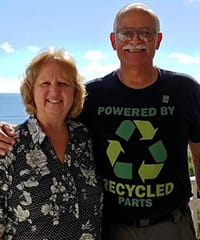The Challenge: Elevated Liver Enzymes
In 1973, Joe St. Clair was sick with a salmonella infection. It was a simple case of food poisoning that led to a diagnosis of elevated liver enzymes and liver damage.
Over the next few decades, he saw many doctors and had lots of bloodwork done. But no one knew exactly what had caused his liver damage. Although salmonella might have caused the damage, doctors couldn't confirm it.
Joe’s health continued to decline slowly without any noticeable symptoms, until one day his wife, Pam, came home and found him unconscious. She woke him up and rushed him to the hospital, terrified he wouldn’t make it.
Because he had fallen unconscious, the doctors checked the hemoglobin level in his blood. For a man Joe’s age, anything below 13.5 is too low and could have dangerous side effects.
“Joe’s hemoglobin level was 4.2,” Pam said. “The fact that he could walk into the emergency room amazing.”
Doctors kept a close eye on Joe. They saw his enzyme levels continuing to rise and gave him the news that would change his life forever. Joe’s liver was shutting down. He would need a transplant to survive.
The news struck Joe hard. But after years of having no idea what caused his liver damage, he thought a transplant would mean finally getting healthy.
Doctors referred him to the Thomas E. Starzl Transplantation Institute at UPMC to begin his life-changing transplant journey.
The Path to Living Donation: Becoming a Champion
During Joe’s pre-transplant appointment and tests, he learned that his diagnosis was more complex than elevated liver enzymes. He had liver cancer.
If his cancer progressed while waiting, then he would no longer be eligible for a deceased-donor liver transplant.
To explore all their options, Joe and Pam met with Swaytha Ganesh, MD, medical director of the UPMC Living Donor Program. They spoke about the possibility of a living-donor liver transplant.
During a living-donor liver transplant, a transplant surgeon removes a portion of a donor’s healthy liver. They then transplant it into the recipient to replace their unhealthy liver.
More than 14,000 people are waiting for a liver transplant in the United States. Living donation offers a life-saving alternative to waiting for a deceased-donor liver to become available. It allows patients to have a transplantsooner if they can find a suitable living donor.
Joe and Pam had no idea how to start looking for a donor. Dr. Ganesh told them about UPMC's Living Donor Champion workshop. She urged them to attend, where Pam could become Joe’s Champion.
A Champion provides support to their loved one who is waiting for a transplant and helps search for a living donor. As Joe’s Champion, Pam created a Facebook page and began to share Joe’s story with anyone who would listen.
“The Champion Program was wonderful because it gave Joe’s need for a living donor a voice. It wasn’t like going door to door asking, ‘could you help us?’” Pam said.
Often, there’s no need to even ask people to donate. Simply by sharing your story, people around you will start to ask themselves what they can do to help. Some of them may even ask how to donate.
The Solution: A Long-Distance Donor
Joe let his wife, and Champion, handle the process of finding a donor. Although he had concerns about asking anyone to donate for him, Pam was confident that she would find a donor.
Four people offered to donate right away. But, after testing, none of them was a suitable donor, and Pam started to feel anxious.
“I was getting very nervous as the Champion, because if I couldn’t find a donor, what would I do?” Pam said.
But she felt more optimistic when Joe’s cousin Barb decided to have a living-donor transplant evaluation.
Barb had a husband and three boys and lived four hours away in Virginia, but knew she needed to help Joe.
At her appointment in early November 2017, Barb learned she was a good match. She and Joe had a successful living-donor liver transplant on Nov. 13, 2017.
The Results: A Healthy Life Ahead
Since the transplant, Joe and Barb both had a full recovery.
Today, Joe marvels over how far he has come.
“Before I received the transplant, I didn’t have much hope I would survive with liver cancer and serious liver damage. The outlook was not very positive,” Joe said. “Now I know I have a healthy life ahead of me.”
Because he feels healthy again, he can spend time outdoors and go fishing without worrying about his health. After a long kayaking and fishing trip with his family, he expected to be sore the next day, like usual. But he woke up feeling great.
“I'm amazed. My strength and energy are back. Keeping a positive attitude about everything really helped,” Joe said.
Most living donors can return to their normal active lives within a few months. For Barb, the recovery process was a bit of a challenge, but being healthy before the surgery helped.
“I was really jealous of Joe. He was up walking in the halls, and I didn’t even want to get out of bed,” Barb joked.
Luckily, it didn’t take long for her to get up and walk herself, and she's feeling completely back to normal now. Barb feels so fortunate that she was able to help Joe and see him make such incredible progress.
Joe and Pam are forever thankful for Barb and her selfless act to save Joe’s life.
“A lot of positive has come out of this,” Joe said. “I would recommend that anyone who is having problems like this reach out to UPMC. The whole team is phenomenal.”
Joe and Barb’s treatment and results may not be representative of all similar cases.
Learn More About Living-Donor Liver Transplant
From our HealthBeat blog:

















